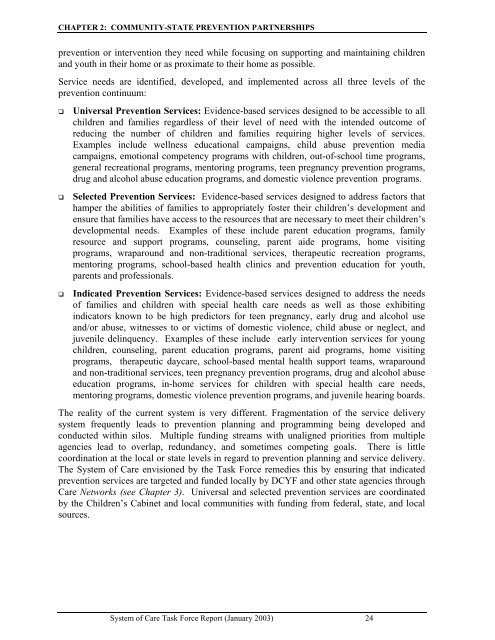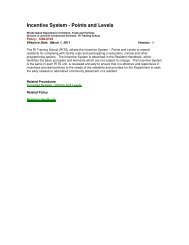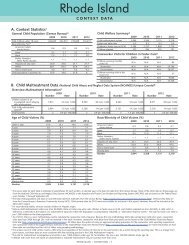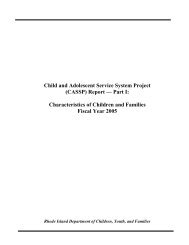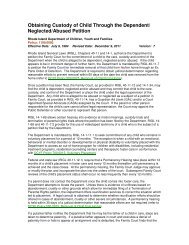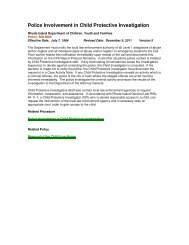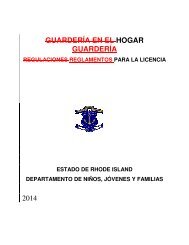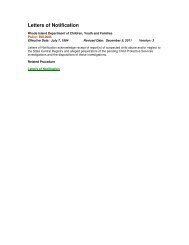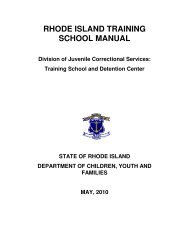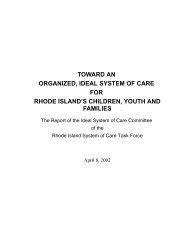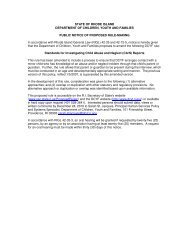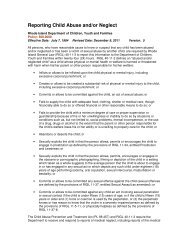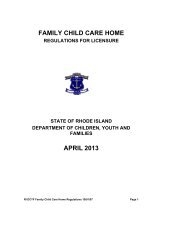Final Report - RI Department of Children, Youth & Families
Final Report - RI Department of Children, Youth & Families
Final Report - RI Department of Children, Youth & Families
Create successful ePaper yourself
Turn your PDF publications into a flip-book with our unique Google optimized e-Paper software.
CHAPTER 2: COMMUNITY-STATE PREVENTION PARTNERSHIPS<br />
prevention or intervention they need while focusing on supporting and maintaining children<br />
and youth in their home or as proximate to their home as possible.<br />
Service needs are identified, developed, and implemented across all three levels <strong>of</strong> the<br />
prevention continuum:<br />
! Universal Prevention Services: Evidence-based services designed to be accessible to all<br />
children and families regardless <strong>of</strong> their level <strong>of</strong> need with the intended outcome <strong>of</strong><br />
reducing the number <strong>of</strong> children and families requiring higher levels <strong>of</strong> services.<br />
Examples include wellness educational campaigns, child abuse prevention media<br />
campaigns, emotional competency programs with children, out-<strong>of</strong>-school time programs,<br />
general recreational programs, mentoring programs, teen pregnancy prevention programs,<br />
drug and alcohol abuse education programs, and domestic violence prevention programs.<br />
! Selected Prevention Services: Evidence-based services designed to address factors that<br />
hamper the abilities <strong>of</strong> families to appropriately foster their children’s development and<br />
ensure that families have access to the resources that are necessary to meet their children’s<br />
developmental needs. Examples <strong>of</strong> these include parent education programs, family<br />
resource and support programs, counseling, parent aide programs, home visiting<br />
programs, wraparound and non-traditional services, therapeutic recreation programs,<br />
mentoring programs, school-based health clinics and prevention education for youth,<br />
parents and pr<strong>of</strong>essionals.<br />
! Indicated Prevention Services: Evidence-based services designed to address the needs<br />
<strong>of</strong> families and children with special health care needs as well as those exhibiting<br />
indicators known to be high predictors for teen pregnancy, early drug and alcohol use<br />
and/or abuse, witnesses to or victims <strong>of</strong> domestic violence, child abuse or neglect, and<br />
juvenile delinquency. Examples <strong>of</strong> these include early intervention services for young<br />
children, counseling, parent education programs, parent aid programs, home visiting<br />
programs, therapeutic daycare, school-based mental health support teams, wraparound<br />
and non-traditional services, teen pregnancy prevention programs, drug and alcohol abuse<br />
education programs, in-home services for children with special health care needs,<br />
mentoring programs, domestic violence prevention programs, and juvenile hearing boards.<br />
The reality <strong>of</strong> the current system is very different. Fragmentation <strong>of</strong> the service delivery<br />
system frequently leads to prevention planning and programming being developed and<br />
conducted within silos. Multiple funding streams with unaligned priorities from multiple<br />
agencies lead to overlap, redundancy, and sometimes competing goals. There is little<br />
coordination at the local or state levels in regard to prevention planning and service delivery.<br />
The System <strong>of</strong> Care envisioned by the Task Force remedies this by ensuring that indicated<br />
prevention services are targeted and funded locally by DCYF and other state agencies through<br />
Care Networks (see Chapter 3). Universal and selected prevention services are coordinated<br />
by the <strong>Children</strong>’s Cabinet and local communities with funding from federal, state, and local<br />
sources.<br />
System <strong>of</strong> Care Task Force <strong>Report</strong> (January 2003) 24


